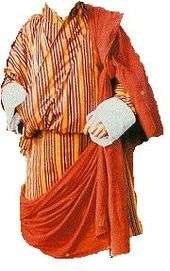Kabney
.jpg)

A kabney (Dzongkha: བཀབ་ནེ་; Wylie: bkab-ne) is a silk scarf worn as a part of the gho, the traditional male costume in Bhutan.[1] It is raw silk, normally 90 by 300 centimetres (35 in × 118 in) with fringes. Kabney is worn over the traditional coat gho; it runs from the left shoulder to the right hip, and are worn at special occasions or when visiting a dzong. Kabney is also referred as Bura which means silk.
The use of gho and kabney is encouraged in Bhutan as a part of driglam namzha (or driklam namzhak), the official behaviour and dress code of Bhutan. Gho is thus compulsory for schoolboys and government officials.[1][2] The female traditional dress is called kira. A rachu is worn over the traditional dress kira.[1][3]
The rank of the bearer determines the colour of the scarf:[4][2][5][6]
- Saffron scarf for the Druk Gyalpo (king) and the Je Khenpo (chief abbot).
- Orange scarf for Lyonpos (ministers and other members of the government).[2]
- Red scarf for Dashos (male members of the royal family and higher officials).[2]
- Green scarf for judges.
- Blue scarf for members of the National Assembly and members of parliament.[7]
- White scarf with red stripes for Gups (headmen of the 205 gewogs).[8]
- White scarf for ordinary citizens.[9]
Former scarf ranks include:
- White scarf with blue stripes for Chimi (members of the National Assembly).
- Blue scarf for lodoe Tsoggde.
References
- 1 2 3 Gyurme Dorje. Footprint Bhutan. Footprint, [2004]. ISBN 1-903471-32-X. Section "National dress", p 261
- 1 2 3 4 Kabney & Patang; from the blog "Bhutan Land Of The Thunder Dragon" by Yeshey Dorji
- ↑ Bhutan Majestic Travel
- ↑ Kabney colour mania; bhutanobserver.bt, august 19th, 2011
- ↑ The Symbolism of Kabney and Rachu in Bhutan; blog "Asian University For Women Academic Reading/Writing 2011"
- ↑ Bhutanese Society and Dress; Bhutan Life Exposure Tours & Treks
- ↑ Blue Kabney (Scarf) for members of parliament; bhutanmajestictravel.com
- ↑ His Majesty grants dhar and kabney to the Gups; bbs.bt
- ↑ Time for the white kabney; bhutanobserver.bt, May 3rd, 2013